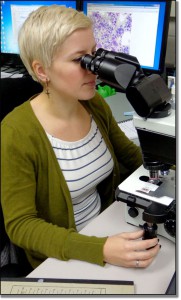A poster presentation looking at whether it’s better for women served by public health laboratories like the WSLH to have molecular-based HPV testing as their primary cervical cancer screening method vs. using a Pap test in combination with an HPV test won the Cytotechnologist Scientific Presentation Award at the 62nd Annual Meeting of the American Society of Cytopathology last month.

WSLH Cytology Lab Manager Erin McCarthy
WSLH Cytology Laboratory Manager Erin McCarthy (pictured at left) was lead author on “Molecular Testing and Cervical Screening: Will One Test Fit All?”. Changhong Ye, instructional program manager in the Cytotechnology Certificate program, and WSLH Medical Director Dr. Dan Kurtycz were co-authors.
Human Papillomavirus (HPV) is the primary cause of nearly all cervical cancers. Nationally, there is an increasing emphasis on using molecular HPV testing as the first-line test for cervical cancer screening. But because the women the WSLH Cytology Laboratory serves tend to be higher-risk for cervical cancer and also medically underserved, McCarthy and her colleagues wanted to know if this change in testing algorithms would be helpful or harmful.
Their research found that nearly 56% of the women determined to have high-grade cervical lesions by Pap tests performed at the WSLH ended up testing negative by molecular testing for the two most common forms of HPV responsible for cervical cancer. If only the molecular HPV tests had been used for these women, their pre-cancerous lesions would have been missed at this stage of testing.
Erin and her co-authors call into question the move toward molecular HPV testing for everyone and note that as cervical cancer screening practices evolve, it will be important to consider whether different populations of women may need different testing algorithms.
“Erin deserves an immense amount of credit for this paper,” said Dr. Kurtycz. “We are all very proud of her work in this area of public health.”
